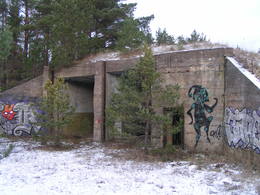Sulev Truuväärt prisiminimai
Dejeve tarnavęs salos gyventojas majoras Sulevas Truuväärtas prisiminė, kad jo metu dalinyje žuvo vienas kareivis.
Nelaimingas incidentas įvyko sargybos kambaryje, saugančiame raketų pozicijas. Sulevas dirbo prie šios bylos karo tyrėju. Kai jis atvyko, vyras dar buvo gyvas, bet mirė pakeliui į ligoninę. „Viskas buvo aptaškyta krauju, kareiviai vėmė, kaltininkas, seržantas, tris dienas negalėjo kalbėti“, – apie siaubingą dieną prisimena Truuväärtas. Sargybos vadas savo kambaryje valė pistoletą, o tai tame kambaryje iš tikrųjų buvo draudžiama. Tuo pačiu metu į sargybos kambarį buvo įleistas vyresnysis leitenantas, kuris taip pat buvo komjaunimo sekretorius. Jam ten nebuvo leidžiama būti. Sargybos vadas surinko pistoletą, kai tuo metu įėjo sargybos vado padėjėjas, nelaimingasis seržantas. Pamatęs pistoletą, jis paprašė jį laikyti. Žinoma, vaikinas nepagalvojo, kad pistoletas užtaisytas, todėl paspaudė gaiduką po durimis. Pasigirdo trenksmas, ir vyras, kuris lankėsi sargybos kambaryje, buvo pataikytas. Kulka pervėrė širdį, per galvą į oro išleidimo angą. Žudikas gavo trejus metus kalėjimo.
Laikraštis "Oma Saar" 2008.07.26
Susijusios vietos
Dejevo karinė ir priešlėktuvinių raketų S-200 bazė
Dejevo karinė bazė ir jos raketų aikštelė yra Saremos salos viduryje, netoli Karujervės ežero.
Po Savitarpio pagalbos pakto pasirašymo 1940 m. gegužės 15 d. Raudonoji armija pradėjo statyti didelę 5000 hektarų karinę bazę Saremos saloje, įskaitant mokymo ir šaudymo aikšteles bei tankų parką. Bazei įrengti buvo pasirinkta vaizdinga smėlėta vietovė, apsupta pušynų, netoli Karujervės. Kareivines pastatė valstybinė įmonė „Ehitaja“. Vokiečių okupacijos metu kompleksas buvo naudojamas kaip karo belaisvių stovykla. Po karo čia buvo dislokuoti desantiniai tankai, o pratybos vykdavo Karujervės ežere. Septintajame dešimtmetyje Karujervėje buvo dislokuotos raketos. 1966 m. prie čia dislokuotų S-125 raketų prisijungė galingesnės S-200 raketos. Be to, bazė aprūpino visas kitas Saremos salos raketų bazes raketomis, kurios buvo surenkamos vietoje. Klestėjimo laikais čia tarnavo 500 kareivių. Vietos gyventojai ir karininkų žmonos gavo darbą karinės bazės „Marat“ siuvimo fabrike. 1959 m. karinė bazė ir jos filialas Sõrvėje buvo pavadinti Dejevu, pagerbiant tariamą sovietų didvyrį Vladimirą Dejevą, kuris žuvo mūšyje.
Okupacinės pajėgos Dejevą paliko 1992 m. Pastatai buvo apiplėšti ir vėliau nugriauti.
Šiuo metu išlikęs buvusio valdymo centro betoninis pastatas, apaugę garažai, kareivinių pamatai ir žvyro sienomis grįstos raketų baterijos.





